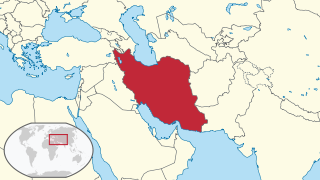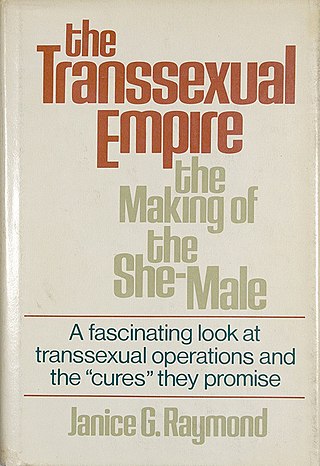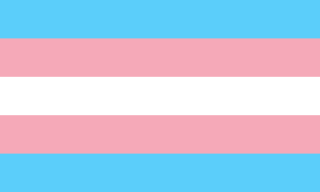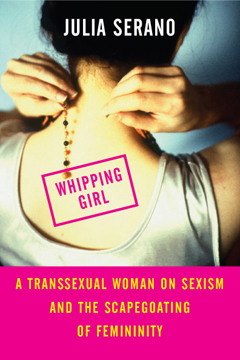Related Research Articles
Cisgender is a term used to describe a person whose gender identity corresponds to their sex assigned at birth. The word cisgender is the antonym of transgender. The prefix cis- is Latin and means 'on this side of'. The term cisgender was coined in 1994 and entered into dictionaries starting in 2015 as a result of changes in social discourse about gender. The term has at times been controversial and subject to critique.

Transphobia is a collection of ideas and phenomena that encompass a range of negative attitudes, feelings, or actions towards transgender people or transness in general. Transphobia can include fear, aversion, hatred, violence or anger towards people who do not conform to social gender expectations. It is often expressed alongside homophobic views and hence is often considered an aspect of homophobia. Transphobia is a type of prejudice and discrimination, similar to racism and sexism, and transgender people of color are often subjected to all three forms of discrimination at once.
Shemale is a term most commonly used in the pornography industry to describe trans women or other people with male genitalia and female secondary sex characteristics acquired via hormones or surgery. Many people in the transgender community consider the term offensive and degrading. Using the term shemale for a trans woman may imply that she is working in the sex trade.
The following outline offers an overview and guide to transgender topics.

A trans man is a man who was assigned female at birth. The label of transgender man is not always interchangeable with that of transsexual man, although the two labels are often used in this way. Transgender is an umbrella term that includes different types of gender variant people. Trans men have a male gender identity, and many trans men choose to undergo surgical or hormonal transition, or both, to alter their appearance in a way that aligns with their gender identity or alleviates gender dysphoria.

"A Cyborg Manifesto" is an essay written by Donna Haraway and published in 1985 in the Socialist Review (US). In it, the concept of the cyborg represents a rejection of rigid boundaries, notably those separating "human" from "animal" and "human" from "machine." Haraway writes: "The cyborg does not dream of community on the model of the organic family, this time without the oedipal project. The cyborg would not recognize the Garden of Eden; it is not made of mud and cannot dream of returning to dust."

Transfeminism, also written trans feminism, has been defined by scholar and activist Emi Koyama as "a movement by and for trans women who view their liberation to be intrinsically linked to the liberation of all women and beyond." Koyama notes that it "is also open to other queers, intersex people, trans men, non-trans women, non-trans men and others who are sympathetic toward needs of trans women and consider their alliance with trans women to be essential for their own liberation." Transfeminism has also been defined more generally as "an approach to feminism that is informed by trans politics." In 2006, the first book on transfeminism, Trans/Forming Feminisms: Transfeminist Voices Speak Out edited by Krista Scott-Dixon, was published by Sumach Press.
Janice G. Raymond is an American lesbian radical feminist and professor emerita of women's studies and medical ethics at the University of Massachusetts Amherst. She is known for her work against violence, sexual exploitation, and medical abuse of women, and for her controversial work denouncing transsexuality and the transgender rights movement.

Transgender rights in Iran are limited, with a narrow degree of official recognition of transgender identities by the government, but with trans individuals facing very high levels of discrimination, from the law, the state, and from the wider society.
Sheila Jeffreys is a former professor of political science at the University of Melbourne, born in England. A lesbian feminist scholar, she analyses the history and politics of human sexuality.
Blanchard's transsexualism typology is a proposed psychological typology of gender dysphoria, transsexualism, and fetishistic transvestism, created by sexologist Ray Blanchard through the 1980s and 1990s, building on the work of prior researchers, including his colleague Kurt Freund. Blanchard categorized trans women into two groups: homosexual transsexuals who are attracted exclusively to men and are feminine in both behavior and appearance; and autogynephilic transsexuals who are sexually aroused at the idea of having a female body.

The Transsexual Empire: The Making of the She-Male is a 1979 book critical of transgender people by American radical feminist author and activist Janice Raymond. The book is derived from Raymond's dissertation, which was produced under the supervision of the feminist theologian Mary Daly.

Allucquére Rosanne "Sandy" Stone is an American academic theorist, media theorist, author, and performance artist. She is currently Associate Professor and Founding Director of the Advanced Communication Technologies Laboratory (ACTLab) and the New Media Initiative in the department of Radio-TV-Film at the University of Texas at Austin. Concurrently she is Wolfgang Kohler Professor of Media and Performance at the European Graduate School EGS, senior artist at the Banff Centre, and Humanities Research Institute Fellow at the University of California, Irvine. Stone has worked in and written about film, music, experimental neurology, writing, engineering, and computer programming. Stone is transgender and is considered a founder of the academic discipline of transgender studies. She has been profiled in Artforum, Wired, Mondo 2000, and other publications, and been interviewed for documentaries like Traceroute.

A transgender person is someone whose gender identity or gender expression does not correspond with their sex assigned at birth. Many transgender people experience dysphoria, which they seek to alleviate through transitioning, often adopting a different name and set of pronouns in the process. Additionally, they may undergo sex reassignment therapies such as hormone therapy and sex reassignment surgery to more closely align their primary and secondary sex characteristics with their gender identity. Not all transgender people desire these treatments, however, and others may be unable to access them for financial or medical reasons. Those who do desire to medically transition to another sex may identify as transsexual.
Womyn-born womyn (WBW) is a term developed during second-wave feminism to designate women who were assigned female at birth, were raised as girls, and identify as women. The policy is noted for exclusion of trans women. Third-wave feminism and fourth-wave feminism have generally done away with the idea of WBW.

Whipping Girl: A Transsexual Woman on Sexism and the Scapegoating of Femininity is a 2007 book by the gender theorist, biologist, and writer Julia Serano. The book is a transfeminist manifesto that makes the case that transphobia is rooted in sexism and that transgender activism is a feminist movement. The second edition of the book was published in March 2016.
Feminist views on transgender topics vary widely. Third-wave feminists and fourth-wave feminists tend to view the struggle for trans rights as an integral part of intersectional feminism. Former president of the American National Organization for Women (NOW) Terry O'Neill has stated that the struggle against transphobia is a feminist issue, with NOW affirming that "trans women are women, trans girls are girls." Several studies have found that people who identify as feminists tend to be more accepting of trans people than those who do not.
Transgender studies, also called trans studies or trans* studies, is an interdisciplinary field of academic research dedicated to the study of gender identity, gender expression, and gender embodiment, as well as to the study of various issues of relevance to transgender and gender variant populations. Interdisciplinary subfields of transgender studies include applied transgender studies, transgender history, transgender literature, transgender media studies, transgender anthropology and archaeology, transgender psychology, and transgender health. The research theories within transgender studies focuses on cultural presentations, political movements, social organizations and the lived experience of various forms of gender nonconformity. The discipline emerged in the early 1990s in close connection to queer theory. Non-transgender-identified peoples are often also included under the "trans" umbrella for transgender studies, such as intersex people, crossdressers, drag artists, third gender individuals and genderqueer people.
TERF is an acronym for trans-exclusionary radical feminist. First recorded in 2008, the term was originally used to distinguish trans-inclusive feminists from a group of radical feminists who reject the assertion that trans women are women, the inclusion of trans women in women's spaces, and transgender rights legislation. Trans-inclusive feminists assert that these ideas are transphobic. Use of the term TERF has since broadened to include reference to people with trans-exclusionary views who are not necessarily involved with radical feminism.
The Transsexual Phenomenon is a medical textbook published by American endocrinologist and sexologist Harry Benjamin in 1966 with The Julian Press. The text is notable for its examination of transsexualism not as a psychological issue, but rather as a somatic disorder that should be treated through medicine. Benjamin argues that transvestism and transsexuality are a spectrum of conditions, requiring different treatments that ranged from hormone replacement therapy to surgical intervention.
References
- 1 2 3 4 Carlos, Matthew Steven (2005). "Stone Publishes a "Posttranssexual Manifesto."". LGBT History, 1988-1992. pp. 78–81. ISBN 9781429800037.
- 1 2 Shrage, Laurie J., ed. (2009). You've Changed: Sex Reassignment and Personal Identity. Oxford University Press. pp. 47, 98. ISBN 978-0-19-974502-9 . Retrieved 29 August 2020.
- ↑ Raymond, Janice (1994). The Transsexual Empire: The Making of the She-Male. Beacon Press. pp. 101–102. ISBN 0-8077-6272-5.
- 1 2 3 4 5 Stryker, Susan; Bettcher, Talia M. (1 May 2016). "Introduction: Trans/Feminisms". TSQ: Transgender Studies Quarterly. 3 (1–2): 5–14. doi: 10.1215/23289252-3334127 . ISSN 2328-9252.
- ↑ Riedel, Samantha (17 October 2019). "How Sandy Stone "Struck Back" Against Transmisogyny". them. Retrieved 29 August 2020.
- ↑ Goldberg, Michelle (4 August 2014). "What Is a Woman?". The New Yorker. Retrieved 30 August 2020.
- ↑ Bettcher, Talia; Garry, Ann (2009). "Introduction". Hypatia. 24 (3): 2–3. ISSN 0887-5367. JSTOR 20618161.
- ↑ Drucker, Zackary (19 December 2018). "Sandy Stone on Living Among Lesbian Separatists as a Trans Woman in the 70s". Vice. Retrieved 29 August 2020.
- ↑ Rose, Jacqueline (5 May 2016). "Who do you think you are?". London Review of Books. 38 (9). ISSN 0260-9592 . Retrieved 29 August 2020.
- ↑ Rooke, Alison (April 2008). "Review of The Transgender Studies Reader". Culture, Health & Sexuality. 10 (3): 307–308. ISSN 1369-1058. JSTOR 20461007.
- 1 2 3 4 5 6 7 8 9 10 11 12 13 14 15 16 Stone, Sandy (2014). The Empire Strikes Back: A Posttranssexual Manifesto (PDF). Retrieved 30 August 2020.
- 1 2 3 Bettcher, Talia (2014). "Feminist Perspectives on Trans Issues". The Stanford Encyclopedia of Philosophy. Retrieved 29 August 2020.
- ↑ Coffman, Chris (1 February 2010). "Woolf's Orlando and the Resonances of Trans Studies". Genders 1998-2013. Retrieved 8 September 2020.
- ↑ Bow, Leslie (2010). Partly Colored: Asian Americans and Racial Anomaly in the Segregated South. New York University Press. ISBN 978-0-8147-9132-5 . Retrieved 8 September 2020.
- 1 2 Kramarae, Cheris; Spender, Dale, eds. (2000). Routledge International Encyclopedia of Women: Global Women's Issues and Knowledge. Routledge. p. 1968. ISBN 978-0-415-92088-9.